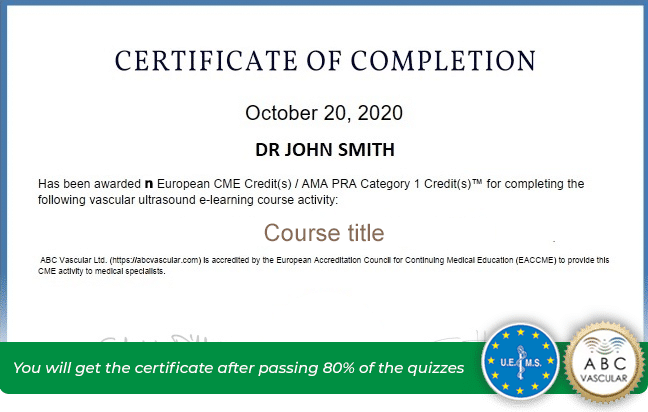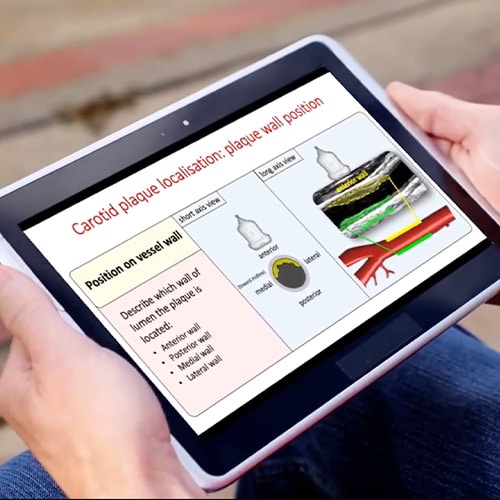

Carotid Atherosclerotic Plaque Assessment Course
Learn how to detect and characterise a carotid plaque with ultrasound. We cover the entire spectrum of the Carotid Atherosclerotic Plaque Assessment with videos, slides, and quizzes; CME credit is available.

Get Started
About the Carotid Atherosclerotic Plaque Assessment course
Course Overview
Carotid atherosclerosis is one of the main risk factors for the occurrence of ischemic stroke. When imaging carotid atherosclerosis, the percentage of the degree of the luminal stenosis is considered the main criteria to determine the best management (surgical – endoarterectomy or stent – or medical) of patients. However, several data have suggested to use carotid atherosclerotic plaques characterisation and plaque progression along with stenosis grading for a better cerebrovascular risk stratification.
Aim of this course
Ultrasound practitioners should be aware of all the potentials that ultrasound holds in detecting ultrasound traits of carotid plaques that are more likely to cause a cerebrovascular event. This online accredited ultrasound course on carotid ultrasound imaging and characterisation of carotid plaques is designed to provide ultrasound imaging practitioners with a comprehensive overview on how to perform a detailed ultrasound assessment of the morphological features of atherosclerotic plaques of the carotid arteries.
How is the course structured?
The course is made of e-booklets supported by hands-on commented video cases and image case library showing different types of carotid plaques, ranging from simple homogeneous echogenic plaques to “vulnerable” plaques showing surface ulceration, plaque rupture, thrombosis and carotid occlusion.
The content of the course is continuously implemented and updated.
What will I get at the end of this course?
At the end of this course, the ultrasound practitioner will have acquired enough knowledge on how to characterise carotid atherosclerotic plaques using ultrasound.
Learn carotid plaques ultrasound imaging assessment with ABC online courses. At the end of the course an European certificate of accreditation and 6 CME AMA PRA credits will be released to the learner after successfully passing multiple quizzes.
Gain an European Certificate
Our courses are accredited by the European accreditation council for continuing medical education to provide CME credits.

Medical e-learning is now widely used by students and healthcare professionals as:
- it offers the possibility to learn at their own pace
without the barriers of location - takes 40% to 60% lesser time for employees and students than conventional learning.

Course includes
- 4 video lectures
- 3 e-booklets containing over 100 slides
- 5 quizzes
- 6 CME or AMA PRA Credits
Course length

- Estimated 6 hours or more to cover videos, slides & quizzes
- Self-paced learning
- Access to this course is for 12 months from date of purchase
Access anywhere

- Mobile friendly
- Learn on-the-go
- Access on PC, phone or tablet
Who may benefit from this course?
Any healthcare professional who is approaching vascular ultrasound for the first time as well as healthcare professionals who want to improve their knowledge and skills in different areas of vascular ultrasound. Our subscribers are:
- trainee medical doctors
- vascular and general sonographers
- nurses
- as well as consultant medical doctors
- as vascular surgeons,
- cardiologists,
- internists,
- angiologists,
- radiologists,
- or somewhat all healthcare professionals involved in the diagnosis and management of peripheral vascular diseases.
Test a lesson free
Not Convinced? Get Started For Free with Two Topics
Start by accessing the first two lessons of all courses for FREE. Courses are created by top experts in the field. If you’re new to the ABC learning method and you are not sure whether is right for you, this will help you to understand what to expect from ABC courses.
Carotid Atherosclerotic Plaque Assessment course review
Learner Reviews
Why this course?
Ultrasound imaging is a safe, non-invasive first level examination used to describe features of carotid atherosclerotic plaques of the carotid arteries. Sonographic plaque characteristics are considered to be predictive of subsequent cerebral ischemic events.
Carotid ultrasound allows to determine several traits of carotid plaques namely echogenicity, characteristics of the surface and more generally morphology. All these features provide clues to differentiate a so defined “vulnerable” from a “non-vulnerable” carotid plaque, thus helping in patients risk stratification and management. Indeed, vulnerable carotid plaques are more prone to cause cerebral embolic events regardless of degree of stenosis and a high proportion of resulting strokes are likely due to rupture or erosion of unstable plaques irrespective of the degree of stenosis.
Lessons in this course
Start with free access to the sample lessons below. Purchase via credit-card for immediate access to the full course.




Alessio L.